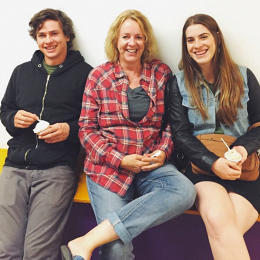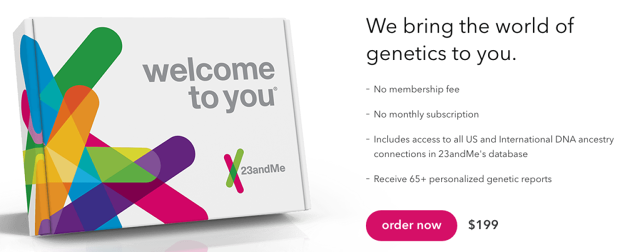She Found Her Biological Father On Ancestry And 23andMe
When she was 22, Jordon Goulder lost her dad to the neurodegenerative disease called ALS. That same year, she discovered that he wasn’t her biological father.
Goulder, who is now 26 and works in public relations, learned from her mother that her parents had experienced fertility troubles before she was born. A fertility specialist recommended that they try an anonymous sperm donor. Her parents agreed to keep this quiet until her father passed away.

Goulder was curious about her biological father from the outset: Was he alive and healthy? Did he have children or share her features? Her mother didn’t have much information aside from a few biographical details and the name of the facility, which had subsequently shut down. When Jordon tried calling the hospital next door, the operator laughed at her request and muttered something about patient privacy before hanging up. “I was emotional at the time, so I don’t remember the conversation verbatim,” she remembers. “It was enough to stop me from looking for him for quite a while, and caused me to harbor some anger that I may never have access to information about my genes.”
But Goulder didn’t give up for good. She sent in samples of her saliva to various consumer-genetics services, which connect users with their family members. On two of these sites, 23andMe and FamilyTreeDNA, she was connected to one of her biological father’s cousins. But AncestryDNA revealed a direct match to a man who chose to publish his name, as well as other relatives with the same last name. She quickly found his profile on Facebook, and noted that they shared the same thick, dark eyebrows. From there, she was able to track down a daughter who happened to live nearby in Portland, Oregon. “I know what she looks like so I look for her all the time, but also fear that I’ll run into her,” she says.
Goulder is far from alone in using these services to find a biological parent. Due to a lack of record keeping, it’s far from clear how many children each year are conceived via a sperm or egg donor, although some estimate that it ranges between 30,000 and 60,000 a year in the U.S. Sites such as Donor Sibling Registry have popped up to offer advice and a community to donors and donor-conceived people, including guiding them to DNA databases with more than 50,000 members where they can be matched with relatives.
“As the database grows, the probability that a user will find a close genetic relative increases,” says Ken Chahine, executive vice president at Ancestry. “But it wasn’t designed for that purpose.”
Goulder attempted to get in touch with her donor via Facebook and Ancestry’s messaging services, but she doesn’t know if he received her message. He hasn’t logged in for a while. It’s possible that he doesn’t want to know her, has pushed the whole thing out of his mind, or simply doesn’t know she’s trying to contact him.

Not So Anonymous
In an age of consumer DNA testing, some bioethicists say that it’s time to revisit the notion of anonymous sperm donation. Is it really possible in this day and age to keep a donor’s identity anonymous? And should the sperm banks do more to warn potential donors that they might be found if they or a relative submits their DNA to a genealogical service?
“When these sperm banks were set up, there were often confidentiality agreements in which a prospective father would say that he never wanted to be contacted, or that he’d be open to it when the child is 18,” says Kayte Spector-Bagdady, a postdoctoral research fellow at the Center for Bioethics & Social Sciences in Medicine at the University of Michigan. “But services like 23andMe have created an additional opportunity that supersedes these previous arrangements, where children created by egg or sperm donors can figure it out.”
23andMe CEO Anne Wojcicki says that one of the three major reasons that people sign up is to find family members: “The adoptive community and sperm donor community are really active.”
At a minimum, Spector-Bagdady recommends that sperm banks disclose this to their potential donors. Others have gone a step further in calling for lawmakers to ban anonymity altogether, arguing that donor offspring like Goulder should have the right to know the identity of their biological parents.
“If a donor doesn’t want to be found, they simply shouldn’t donate,” says Wendy Kramer, director of Donor Sibling Registry, which is a not-for-profit organization. “Yet the sperm banks don’t tell prospective donors that because they’ll make less money.” Kramer says her son was one of the earliest users of these sites, and figured out the identity of his donor back in 2005.
One sperm donor I spoke to, who requested anonymity, said he had his own reservations about DNA-testing services, but he didn’t discuss this with the sperm bank. Moreover, as far as he could tell, the facility didn’t ask for references or verify anything he told them about his Ivy League education or health history.
He had donated sperm on a whim after graduating with a mountain of college debt (“My thinking at the time was that if I got $100 every time I masturbated, that’s a good deal”). He put the experience to the back of his mind until our conversation, in which he shared myriad concerns. “They seemed to want people with attractive qualities, but those people might be sensitive to requests to speak to their mother or their college,” he said. “It was a balancing act of attracting donors, while reducing friction.”
According to Kramer, the root of the problem is the lack of rules or regulation when it comes to buying and selling sperm. For instance, the U.S. Food and Drug Administration requires that donors get tested for some communicable diseases, but there is no federal requirement that sperm banks screen for genetic diseases. As a result, testing practices vary widely among different facilities.

In recent years, cases have hit the headlines where a donor unknowingly has hundreds of children, or wasn’t properly tested for various genetic diseases. One family was told that a donor had a clean bill of health, but their child was born with cystic fibrosis. Both the mother and the donor were carriers of the disease.
Kramer adds that sperm banks are also inconsistent in how they mediate relationships between donors and their offspring. She says that many will send an ambiguous letter in the mail, and then call it a day. Cases have reached the courts where sperm banks failed to notify a family when a donor gets sick or has a history of disease, or didn’t amend their donor’s medical profile as new medical information came to light.
Of a handful of sperm banks contacted by Fast Company, only California Cryobank responded to a request for comment. Company spokesman Scott Brown stressed that the team will facilitate contact when the child is 18, if the donor is open to it. He says many donors who requested anonymity are willing.
Brown agrees that the rise of commercial DNA testing companies has been transformative, but he doesn’t agree that all anonymity should be waived. “It would be unreasonable for a sperm donor today to believe they’ll never be contacted,” he says. In light of this, he urges donor offspring to wait until they’re 18 and initiate contact through the sperm bank rather than through 23andMe, Facebook, and the like. “That sets up a difficult and devastating situation for both parties,” he says. “If you’re going to show up on the guy’s doorstep, it could affect his life and jeopardize things for all other offspring that might be waiting the proper amount of time.”
Brown says the company will screen potential candidates to check if they’re a carrier for a variety of genetic diseases, including cystic fibrosis and spinal muscular atrophy.
Ethical Implications
Ancestry’s team has researched the implications of customers using the service to connect with donor or adoptive parents. Their core mission is to help people understand their origins. Several years ago, the company invited a group of bioethicists into their offices to figure out what to do. “They were in favor of giving the right information to people, rather than trying to hide it,” says Chahine. But all those who register for the site can request anonymity so their identity wouldn’t be revealed to a donor offspring, for instance.
23andMe’s Wojcicki says the team has thought about ways to adequately educate users about surprising results. Users have learned through the site that they were adopted or donor-conceived, before a parent told them the truth. Research from 2005 found that cases of paternity discrepancy, when a child is identified as being biologically fathered by someone other than the man who believes he is the father, occurs between .8% to 30% in the population.
The company’s terms and conditions make it explicitly clear: “This information may evoke strong emotions and has the potential to alter your life and worldview. You may discover things about yourself that trouble you and that you may not have the ability to control or change.”
Experts are divided on whether these sites should be doing more to educate and inform their users. Spector-Bagdady commends 23andMe for its explicit language, but is concerned that few people read the terms of service. She has argued in the past that this information is inherently medical, as it relates to family medical histories, and that direct-to-consumer companies have enhanced obligations to return these results more like clinicians than for-profit businesses. It’s unclear how they would do that, as these sites don’t know ahead of time whether they’re delivering surprising results. “From an ethical perspective, it’s still very much up for debate,” she says.

All told, those I spoke to who connected with donor parents or half-siblings relayed mostly positive experiences. One 23andMe user in her mid-forties, who goes by the pseudonym Marcia, has bonded with her eight new brothers and sisters. None of them never met their biological father, who passed away at a fairly young age. “This has been a huge and unexpected blessing,” she says. “You’ll find many people who are angry or feel a loss of identity, but this struck us differently.”
Jordon Goulder’s wedding is coming up in a few weeks. For the time being, she’s hit the pause button on her search for her biological father. She’s considering a certified letter at some point, so at least she’ll know if he’s received it. Her friends are confident that he submitted DNA to Ancestry, so he must be curious. She’s keeping her hopes up. “I think it will happen eventually.”
Fast Company , Read Full Story
(44)


